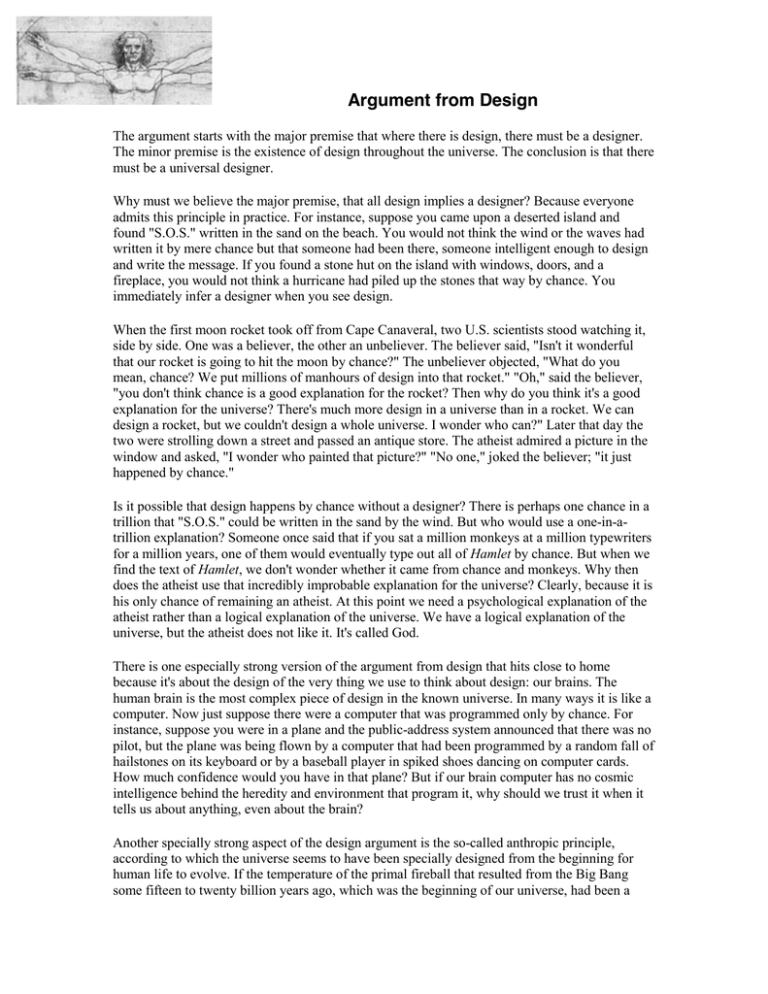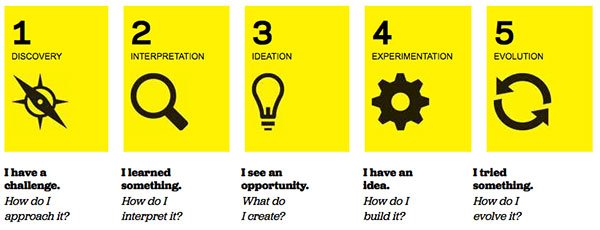Table Of Content

Plato's teleological perspective is also built upon the analysis of a priori order and structure in the world that he had already presented in The Republic. Scientists have determined that life in the universe would not be possible if more than about two dozen properties of the universe were even slightly different from what they are; as the matter is commonly put, the universe appears “fine-tuned” for life. For example, life would not be possible if the force of the big bang explosion had differed by one part in 1060; the universe would have either collapsed on itself or expanded too rapidly for stars to form. Similarly, life would not be possible if the force binding protons to neutrons differed by even five percent. Further, scientists in many fields typically infer the causal activity of intelligent agents from the occurrence of information content.
Part V. Thomas Aquinas, "The Argument from Design"
Anyone who found this watch, having never seen a watch before, would have to conclude that someone designed it for it to fulfil its purpose of keeping time. It points to evidence that suggests our world works well - ie that it was designed in a specific way. The argument follows that if it was designed like this, then someone or something must have designed it.
1 In Which Sense Are Life-Friendly Conditions Improbable?
Existing neural network models learn a semantic representation for each argument from its compositional words and classify discourse relation by the interactive semantic representation of an argument pair. As the basic English unit, a word only carries a simple and limited meaning that may be incorrectly interpreted in an argument without considering its syntactic context. This motivates us to explore whether we can learn an argument’s semantic representation from another language unit phrase which usually contains full contextual meaning. We also argue that some semantic connection in between phrase pairs can be further exploited to infer the discourse relation between arguments.

1 The Argument from Fine-Tuning for Design Using Probabilities
Even though we are sympathetic to this serious charge, we think it’s helpful to to see why, even in its own framework, the multiverse fails to be a good scientific explanation for fine-tuning. The great clue to solving the mystery of the constants came from the surprising discovery of fine-tuning - the fact that the specific values of the constants are not arbitrary, but are highly fine-tuned to allow our complex universe to emerge. In the latter half of the 20th century, scientists discovered that if these numbers were slightly different, there would be no atoms, molecules, planets, life, stars, or galaxies. According to many contemporary physicists, the most deeply problematicinstances of fine-tuning do not concern fine-tuning for life butviolations of naturalness—a principle of theory choicein particle physics and cosmology that can be characterized as ano fine-tuning criterion. Biological organisms are fine-tuned for life in the sense that theirability to solve problems of survival and reproduction dependscrucially and sensitively on specific details of their behaviour andphysiology. For example, many animals rely on their visual apparatusto spot prey, predators, or potential mates.
The Argument from Design for the Existence of God

Arguments according to which our universe isfine-tuned for life are aimed at showing that life could not haveexisted for the vast majority of other forms of the laws of nature,other values of the constants of nature, and other conditions in thevery early universe. Though Aquinas died long ago, his arguments still live on in today’s discourse, exciting passionate argument. William Paley (1743–1805) proposed a teleological argument, sometimes called the design argument, that there exists so much intricate detail, design, and purpose in the world that we must suppose a creator.
Higher likelihood of \(h_1\) than \(h_2\) on specific evidence doesnot automatically imply that \(h_1\) is likely to be true, or isbetter in some overall sense than is \(h_2\). \(h_1\) might, in fact,be a completely lunatic theory which nonetheless entails e,giving \(h_1\) as high a likelihood as possible. Such maximallikelihood relative to e would not necessarily alter\(h_1\)’s lunacy. Likelihood thus does not automaticallytranslate into a measure of how strongly some specific evidencee supports the hypothesis \(h_1\) in question (Jantzen 2014a,Chap. 11).
3 Violations of Naturalness and Fine-Tuning for Life
For example, it would be reasonable to infer that some intelligent extraterrestrial beings were responsible for a transmission of discrete signals and pauses that effectively enumerated the prime numbers from 2 to 101. In this case, the intelligibility of the pattern, together with the improbability of its occurring randomly, seems to justify the inference that the transmission sequence is the result of intelligent design. Second, the claim that intelligent agents of a certain kind would (or should) see functional value in a complex system, by itself, says very little about the probability of any particular causal explanation.
What You Missed About the Fine-Tuning Argument - Catholic Answers
What You Missed About the Fine-Tuning Argument.
Posted: Mon, 16 Jan 2023 08:00:00 GMT [source]
In what follows,the motivation, significance, and implementation of this idea in theframework of quantum field theory are explained. For a more detailedintroduction aimed at physicists see Giudice (2008), for one aimed atphilosophers of physics see Williams (2015). Which expresses that life-friendly conditions confirm the designerhypothesis and which likelihoodists such as Sober (2003) regard as atthe core of the argument from fine-tuning for design. Unfortunately, developments in the last few decades have not been kindto hopes of the sort expressed by Einstein.
Understanding Design Arguments: An Introduction for Catholics - Discovery Institute
Understanding Design Arguments: An Introduction for Catholics.
Posted: Mon, 24 Apr 2023 07:00:00 GMT [source]
This general argument form was criticized quite vigorously by Hume, atseveral key steps. Against (1), Hume argued that the analogy is notvery good—that nature and the various things in it are notvery like human artifacts and exhibit substantial differencesfrom them—e.g., living vs. not, self-sustaining vs. not. Indeed,whereas advocates of design arguments frequently cited similaritiesbetween the cosmos on the one hand and human machines on the other,Hume suggested that the cosmos much more closely resembled a livingorganism than a machine. And while (2) may be true in specific cases ofhuman artifacts a, that fact is only made relevant to naturalphenomena e via (3), which underpins the transfer of the keyattribution. Against (3), Hume argued that any number of alternativepossible explanations could be given of allegedly designed entities innature—chance, for instance. Thus, even were (1) trueand even were there important resemblances, the argument might conferlittle probabilistic force onto the conclusion.
If one has a prior commitment to some key α (e.g., totheism, atheism, naturalism, determinism, materialism, or teleology),or assigns a high prior to that α, the plausibility of takingthe proposed (new) explanation as undercutting, defeating, or refutingα (and/or Σ) will be deeply affected, at leastinitially. Along with this perception of mind-suggestiveness went a furtherprinciple—that the mind-suggestive or design-likecharacteristics in question were too palpable to have been generatedby non-intentional means. Whether his suggestions are correct concerning the uncertaincharacter of any designer inferred will depend upon the specificRs and upon what can or cannot be definitively saidconcerning requirements for their production. Some theologians oppose the usage of human reason and science in attaining knowledge of God altogether, asserting the primacy of faith in this endeavour.
Given this limitation, some argue that only a full-blownBayesian analysis should be used to assess competing hypotheses. For acontrast between IBE and Bayesianism, see the entry on abduction.For an important recent critique of theistic design arguments inBayesian terms, see Sober 2009, the reply in Kotzen 2012, andthe response in Jantzen 2014b. If this is correct, then design inferences simply cannot do the job they are asked to do in design arguments for God’s existence.
Richard Bentley saw evidence of intelligent design in Newton’s discovery of the law of gravitation. It is noteworthy that each of these thinkers attempted to give scientifically-based arguments for the existence of God. Like many of the early works that have had a lasting impact on biological thought, Paley’s Natural Theology remains worthy of reading by the current generation of biologists, educators, and students. It presents the argument from design in a clear fashion, unencumbered by the mathematical and biochemical accoutrements with which it recently has been festooned. That arguments very similar to Paley’s are now being used in an attempt to undermine the teaching and acceptance of evolutionary science gives Natural Theology continued relevance.

No comments:
Post a Comment